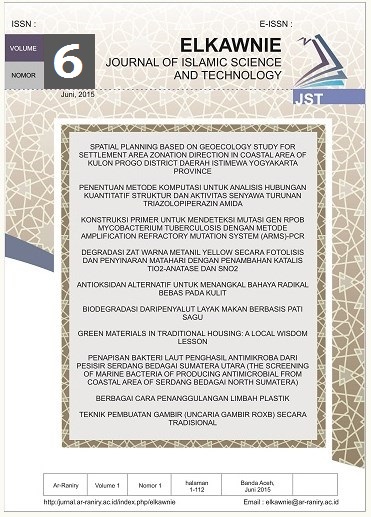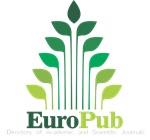Effect of Ethanol Extract of Jamblang Aceh (Syzygium cumini) in Diabetic Mice (Mus musculus) and Its Potential As Anti-Diabetic Agent
DOI:
https://doi.org/10.22373/ekw.v6i1.5496Keywords:
Ethanol extract, Syzygium cumin, Antidiabetes, phytochemicalAbstract
Abstract : This study was designed to evaluate the anti-diabetic activity of the ethanol extract of Syzygium cumini leaves in alloxan-induced diabetes mice. The anti-diabetic activity of EDS was investigated in mice (Mus musculus SW.) Alloxan-induced diabetes. The effect of ethanol extract of Syzygium cumini leaves on normal blood glucose levels and oral glucose tolerance tests were studied in normoglycemic mice while the anti-diabetic effect was evaluated in alloxan-induced hyperglycemic mice. Ethanol extract of Syzygium cumini leaves (200 and 400 mg/kg) is given orally for 21 days. Glibenclamide (5 mg/kg, oral for 21 days) is used as a reference standard. Giving ethanol extract of Syzygium leaves causes a significant decrease in blood glucose levels in normoglycemic and hyperglycemic mice and also increases glucose tolerance test. Ethanol extract of Syzygium leaves reduces glycosylated hemoglobin levels, lactate dehydrogenase, and creatinine kinase in alloxan-treated mice. Ethanol extract of Syzygium leaves also improves TBARS oxidative stress parameters, catalase and superoxide dismutase activity and glutathione levels. The ethanol extract of Syzygium cumini leaves shows anti-diabetic activity through increased insulin secretion and this effect can be attributed to the content of flavonoids and phenolic compounds present in the ethanol extract of Syzygium cumini leaves.
Abstrak : Penelitian ini dirancang untuk mengevaluasi aktivitas anti-diabetes dari ekstrak etanol daun Syzygium cumini (L) Skeels (EDS) pada mencit diabetes yang diinduksi aloksan. Aktivitas anti-diabetes EDS diselidiki pada mencit (Mus musculus SW.) diabetes yang diinduksi aloksan. Pengaruh ekstrak etanol daun Syzygium cumini (EDS) pada kadar glukosa darah normal dan uji toleransi glukosa oral dipelajari pada mencit normoglikemik sedangkan efek antidiabetik dievaluasi pada mencit hiperglikemik yang diinduksi aloksan. EDS (200 dan 400 mg/kg) diberikan secara oral selama 21 hari. Glibenclamide (5mg/kg, oral selama 21 hari) digunakan sebagai standar referensi. Pemberian EDS menyebabkan penurunan signifikan dalam kadar glukosa darah pada mencit normoglikemik dan hiperglikemik dan juga meningkatkan uji toleransi glukosa. EDS mengurangi kadar hemoglobin glikosilasi, laktat dehidrogenase, dan kreatinin kinase pada mencit yang diberi aloksan. EDS juga memperbaiki parameter stres oksidatif TBARS, aktivitas katalase dan superoksida dismutase dan kadar glutathione. Ekstrak etanol daun Syzygium cumini (EDS) menunjukkan aktivitas antidiabetik melalui peningkatan sekresi insulin dan efek ini dapat dikaitkan dengan kandungan flavonoid dan senyawa fenolik yang ada dalam ekstrak daun.
References
Chevrier, G., Mitchell, P., Beaudoin, M. S., & Marette, A. (2016). Impact of Dietary Proteins on Energy Balance, Insulin Sensitivity and Glucose Homeostasis: From Proteins to Peptides to Amino Acids. In The Molecular Nutrition of Amino Acids and Proteins (pp. 241-264). Academic Press. https://doi.org/10.1016/B978-0-12-802167-5.00018-9
Diningrat, D. S., Risfandi, M., Harahap, N. S., Sari, A. N., & Siregar, H. K. (2020). Phytochemical Screening and Antibacterial Activity Coix lacryma-jobi Oil. Journal of Plant Biotechnology, 47(1), 100-106. https://doi.org/10.5010/JPB.2020.47.1.100
Domingueti, C. P., Dusse, L. M. S. A., das Graças Carvalho, M., de Sousa, L. P., Gomes, K. B., & Fernandes, A. P. (2016). Diabetes mellitus: the linkage between oxidative stress, inflammation, hypercoagulability and vascular complications. Journal of Diabetes and its Complications, 30(4), 738-745. https://doi.org/10.1016/j.jdiacomp.2015.12.018
Fan, W. (2017). Epidemiology in diabetes mellitus and cardiovascular disease. Cardiovascular endocrinology, 6(1), 8. https://dx.doi.org/10.1097%2FXCE.0000000000000116
Giles-Rivas, D., Estrada-Soto, S., Aguilar-Guadarrama, A. B., Almanza-Pérez, J., García-Jiménez, S., Colín-Lozano, B., ... & Villalobos-Molina, R. (2020). Antidiabetic effect of Cordia morelosana, chemical and pharmacological studies. Journal of Ethnopharmacology, 112543. https://doi.org/10.1016/j.jep.2020.112543
Hardiana, H., Rasnovi, S., & Zumaidar, Z. (2019). Use of plants as traditional medicine in swamedication in Pidie communities. Jurnal Natural, 19(2), 35-41. https://doi.org/10.24815/jn.v19i2.13192
Huang, H., Ma, H., van Triest, H. J., Wei, Y., & Qian, W. (2018).
Automatic detection of neovascularization in retinal images using extreme learning machine. Neurocomputing, 277, 218-227. https://doi.org/10.1016/j.neucom.2018.04.065
Istiak, A., Hazra, P., Hossain, M. I., Aminatu, A. S., & Rafiq, K. (2018). Hypoglycemic, hypolipidemic and kidney protective potential of combined formulation of Tribulus terrestris and Andrographis paniculata in alloxan induced mice. African Journal of Pharmacy and Pharmacology, 12(21), 269-277.DOI: 10.5897/AJPP2018.4928
Labay, L. M., Caruso, J. L., Gilson, T. P., Phipps, R. J., Knight, L. D., Lemos, N. P., ... & Williams, E. (2016). Synthetic cannabinoid drug use as a cause or contributory cause of death. Forensic science international, 260, 31-39. https://doi.org/10.1016/j.forsciint.2015.12.046
Moghadasian, M. H., Masisi, K., Le, K., Beta, T., Shen, G. X., & Fischer, G. (2019). The Potential Anti-Diabetic Effects of Saskatoon Berry in Experimental Mouse Models. Austin J Nutri Food Sci, 7(1), 1111. https://austinpublishinggroup.com/nutrition-food-sciences/fulltext/ajnfs-v7-id1111.php
Munir, M., & Qureshi, R. (2018). Anti-diabetic plants of Pakistan. In Plant and Human Health, Volume 1 (pp. 463-545). Springer, Cham. https://doi.org/10.1007/978-3-319-93997-1_12
Ng’uni, T., Klaasen, J. A., & Fielding, B. C. (2018). Acute toxicity studies of the South African medicinal plant Galenia africana. Toxicology reports, 5, 813-818. https://doi.org/10.1016/j.toxrep.2018.08.008
Nowak, K., Zawadzki, M., & Jurek, T. (2020). Postmortem determination of HbA1c and glycated albumin concentrations using the UHPLC-QqQ-MS/MS method for the purposes of medicolegal opinions. Microchemical Journal, 155, 104733. https://doi.org/10.1016/j.microc.2020.104733
Panigrahy, S. K., Bhatt, R., & Kumar, A. (2017). Reactive oxygen species: sources, consequences and targeted therapy in type 2 diabetes. Journal of drug targeting, 25(2), 93-101. https://doi.org/10.1080/1061186X.2016.1207650
Picazo, A., Jiménez-Osorio, A. S., Zúñiga-Mejía, P., Pedraza-Chaverri, J., Monroy, A., Rodriguez-Arellano, M. E., & Barrera-Oviedo, D. (2017). Hypoglycemic drugs induce antioxidant aldehyde dehydrogenase activity and remain high in patients with glycemic control in type 2 diabetes. European journal of pharmacology, 800, 57-62. https://doi.org/10.1016/j.ejphar.2017.02.027
Sari, A. N. (2017). Potensi Antioksidan Alami Pada Ekstrak Daun Jamblang (Syzigium Cumini (L.) Skeels). EKSAKTA: Berkala Ilmiah Bidang MIPA, 18(02), 107-112. https://doi.org/10.24036/eksakta/vol18-iss02/61
Sari, A. N., Kusdianti, K., & Diningrat, D. S. (2018). Analisis GC-MS Senyawa Bioaktif Pencegah Penyakit Degeneratif Dari Ekstrak Etanol Kulit Buah Jamblang (Syzygium Cumini). Elkawnie, 4(2), 101-114. http://dx.doi.org/10.22373/ekw.v4i2.4143
Srivastava, A., Srivastava, P., Pandey, A., Khanna, V. K., & Pant, A. B. (2019). Phytomedicine: A Potential Alternative Medicine in Controlling Neurological Disorders. In New Look to Phytomedicine (pp. 625-655). Academic Press. https://doi.org/10.1016/B978-0-12-814619-4.00025-2
Volpe, C. M. O., Villar-Delfino, P. H., dos Anjos, P. M. F., & Nogueira-Machado, J. A. (2018). Cellular death, reactive oxygen species (ROS) and diabetic complications. Cell death & disease, 9(2), 1-9. DOI 10.1038/s41419-017-0135-z
Zimmet, P. Z. (2017). Diabetes and its drivers: the largest epidemic in human history?. Clinical diabetes and endocrinology, 3(1), 1. https://doi.org/10.1186/s40842-016-0039-3
Downloads
Published
Issue
Section
License
Proposed Policy for Journals That Offer Open Access Authors who publish with the Elkawnie journal agree to the following terms:
a. Authors retain copyright and grant the journal right of first publication with the work simultaneously licensed under a Creative Commons Attribution License that allows others to share the work with an acknowledgement of the work's authorship and initial publication in this journal.
b. Authors are able to enter into separate, additional contractual arrangements for the non-exclusive distribution of the journal's published version of the work (e.g., post it to an institutional repository or publish it in a book), with an acknowledgement of its initial publication in this journal.
c. Authors are permitted and encouraged to post their work online (e.g., in institutional repositories or on their website) prior to and during the submission process, as it can lead to productive exchanges, as well as earlier and greater citation of published work (see The Effect of Open Access).

























